
L. Ron Hubbard in the late 1960s, making an adjustment to the Mark V E-Meter. From The Book Introducing the E-Meter, by L. Ron Hubbard. |
Poster presented at the 28th Annual Meeting of the Society for Neuroscience. November 7-12, 1998. Los Angeles, California. Soc. Neurosci. Abstr., 24:241.
Scientology builds upon Dianetics, an abreactive therapy technique Hubbard introduced in 1950. His work mixes ideas from Freud, Jung, Aleister Crowley, and gnostic mysticism.
The scientific trappings of Scientology extend even to instrumentation: a skin galvanometer called an E-meter (electropsychometer) is said to allow an auditor (therapist) to observe the creation or destruction of "mental mass'' by reading the needle movement.
On the most advanced levels of Scientology, adherents learn that they share their bodies with body thetans, alien spirits who have suffered traumatic incidents and are too weak and confused to control bodies of their own. Illness can be caused by body thetans.
The power of other minds to directly affect one's physical well-being is common to many magical belief systems. But Scientology also incorporates the mind-as-computer metaphor, and makes explicit reference to neuroanatomical structures.

L. Ron Hubbard in the late 1960s, making an adjustment to the Mark V E-Meter. From The Book Introducing the E-Meter, by L. Ron Hubbard. |
May 1950: Publication of the 500 page book, Dianetics: the Modern Science of Mental Health, kicks off a Dianetics craze that sweeps the country.
1954: Church of Scientology formed in Los Angeles.
1967: Hubbard creates a new doctrine, OT III (the "Wall of Fire"), that humans are spiritual descendants of space aliens.
1977: FBI agents stage simultaneous raids on Scientology headquarters in Los Angeles and Washington, DC, and discover "an astonishing espionage system which spanned the United States and penetrated some of the highest offices in the land" (Miller, 1988)
1986: L. Ron Hubbard dies while living in seclusion in Creston, California.
1993: after a thirty year battle, Scientology regains its tax exempt status in a secret agreement with the IRS. The agreement was leaked to the Wall Street Journal in 1997.
The mind is also tripartite, consisting of an analytical mind, a reactive mind, and a somatic mind. The analytical mind is a perfectly rational computer, but it drops out during periods of unconsciousness or any painful event. The reactive mind records painful events as "mental image pictures'' called engrams, and recalls them in an associationist fashion that interferes with the analytical mind's computations. The somatic mind is responsible for reflexive, animal-like behaviors.
In his early work, such as Dianetics: Evolution of a Science, Hubbard speculated that the analytical mind might reside in the pre-frontal lobes. The reactive mind was said to rely on a cellular recording mechanism that might also one day be localized to a specific brain area.
But in later writings, Hubbard completely dissociated mind from body, leaving the brain in charge of just autonomic functions and primitive reflexes.
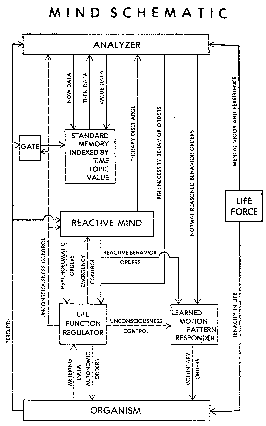 The diagram at left appeared in Dianetics as an appendix contributed
by D.H. Rogers. It shows that "percepts" enter the reactive mind
directly, but they enter the analytical mind's memory bank only
through a gate which blocks the recording of painful experiences. The
gate is also closed during periods of unconsciousness. At these times
persons may accumulate harmful engrams, since experiences are recorded
literally by the reactive mind without the sophisticated analysis the
analytical mind provides.
The diagram at left appeared in Dianetics as an appendix contributed
by D.H. Rogers. It shows that "percepts" enter the reactive mind
directly, but they enter the analytical mind's memory bank only
through a gate which blocks the recording of painful experiences. The
gate is also closed during periods of unconsciousness. At these times
persons may accumulate harmful engrams, since experiences are recorded
literally by the reactive mind without the sophisticated analysis the
analytical mind provides.
Dianetics is the most important book in the Scientology religion. Believers refer to it as "Book One". In later editions (starting in the 1980s) the appendix by Rogers was deleted, in order to purify the book of any thoughts not directly coming from L. Ron Hubbard.
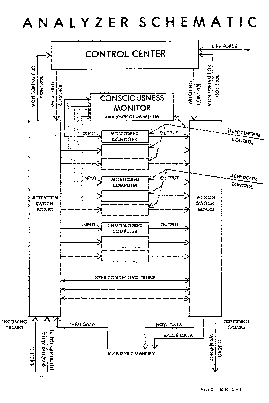 This diagram, also from the Rogers appendix, provides a look inside
the analytical mind. The "analyzer" is composed of some number of
attention units that receive input from the standard memory banks and
perform computations, leading to evaluation of data and to rational
behavior.
This diagram, also from the Rogers appendix, provides a look inside
the analytical mind. The "analyzer" is composed of some number of
attention units that receive input from the standard memory banks and
perform computations, leading to evaluation of data and to rational
behavior.
The reactive mind (previous diagram) can generate behavior too, but its operation is overly-literal and not rational. Because the reactive mind stores painful memories, and unanalyzed events, it tends to propose inappropriate behaviors and interfere with the operation of the analyzer.
Dianetic therapy supposedly opens the pathway from the reactive mind's memory banks to the analyzer (see lower left portion of this diagram), allowing painful memories to be confronted and neutralized.
When he created Scientology as the successor to Dianetics, Hubbard moved from psychology to mysticism. Borrowing from Eastern religion, Scientology teaches that people are immortal beings who have lived thousands of past lives. Painful memories accumulated during those lives must be treated by a type of counseling called "auditing".
In a book called Have You Lived Before This Life?, Hubbard reported several dozen tales of past lives that supposedly came to light during auditing. Some were from recent history; others involved incidents of "space opera," with aliens and ray guns, in civilizations that predate the human race.
People who undergo extensive Scientology auditing are taught to "recall" incidents from their past lives. Scientology is the most systematic, blatant, and successful inducer of False Memory Syndrome currently known.
In response to sweeping claims that Scientology could cure various diseases with the E-meter, the U.S. Food & Drug Administration raided the organization on January 4, 1963 and seized hundreds of E-meters as illegal medical devices.
As a consequence of the raid and the ensuing legal battle, Judge Gerhardt A. Gessell ordered that E-meters carry a legal disclaimer. The curent version of this disclaimer reads as follows (RTC is Religious Technology Center):
By itself, this meter does nothing. It is solely for the guide of Ministers of the Church in Confessionals and pastoral counselling. The Electrometer is not medically or scientifically capable of improving the health or bodily function of anyone and is for religious use by students and Ministers of the Church of Scientology only. HUBBARD, E-METER and SCIENTOLOGY are trademarks and service marks owned by RTC and used with its permission.
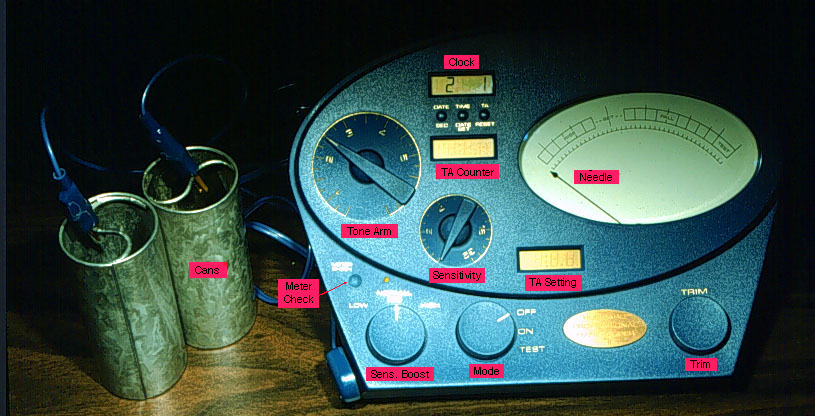
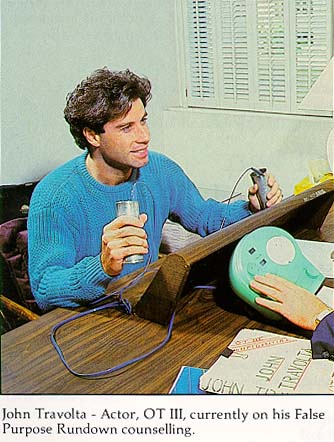 Hollywood actor John Travolta undergoing auditing at a Scientology
facility. Persons receiving auditing are called PCs, or "pre-clears".
The folder at lower right is one of Travolta's PC folders, containing
records of his auditing sessions. All transgressions confessed during
auditing are recorded in the PC folder and kept permanently in the
church's files.
Hollywood actor John Travolta undergoing auditing at a Scientology
facility. Persons receiving auditing are called PCs, or "pre-clears".
The folder at lower right is one of Travolta's PC folders, containing
records of his auditing sessions. All transgressions confessed during
auditing are recorded in the PC folder and kept permanently in the
church's files.
The meter is normally positioned so that it is only visible to the
auditor. It is the auditor's job to interpret the meter movements to
determine the line of questioning to be pursued. A "read" on the
meter in response to a question indicates that there is "charge" on
that topic and it should be investigated further.
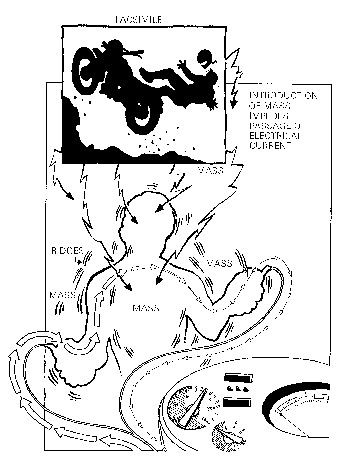 Scientology employs a kind of magical physics in which the "mental
image pictures" stored in the reactive mind have physical mass that
can be measured on a scale.
Scientology employs a kind of magical physics in which the "mental
image pictures" stored in the reactive mind have physical mass that
can be measured on a scale.Memories become more powerful and their "mental mass" increases as attention is placed on them. Memories of extremely traumatic events carry high amounts of "charge" that must be released through auditing.
The variation in current flow measured by the E-meter is attributed either to a change in body resistance resulting from the gain/loss of mental mass as memories are contacted, or to the charge attached to those memories.
Click for larger version.
Illustration from Understanding the E-Meter, by L. Ron Hubbard.
The advanced levels of Scientology are called OT levels because they are supposed to help one recover the state of being OT, meaning "at cause" (having power) over MEST.
In OT III the adherent learns that he has been the victim of a brainwashing scheme perpetrated by Xenu, the galactic ruler 75 million years ago, with the help of psychiatrists. He, as a thetan, is not the sole occupant of his body. Other thetans who are too weak or confused to control bodies of their own are attached to his body, and their reactive minds are in contact with his own, clouding his thoughts and contributing mental mass that registers on the E-meter.
Scientology auditing at the OT levels focuses on making telepathic contact with these "body thetans" and running them off. Essentially, OT auditing is about curing demonic possession via self-exorcism.
Levels OT IV through OT VII, collectively known as NOTs, continue this
procedure.
Data (1)
(1)
The head of the Galactic
Confederation (76 planets around
larger stars visible from here)
(founded 95,000,000 yrs ago, very space opera)
solved overpopulation (250 billion
or so per planet) -- 178 billion
average) by mass implanting.
He caused people to be brought to
Teegeeack (Earth) and put an H Bomb
on the principal volcanoes (Incident 2)
and then the Pacific area ones
were taken in boxes to Hawaii
and the Atlantic Area ones to
Las Palmas and there "packaged."
His name was Xenu. He used
renegades. Various misleading
data by means of circuits etc.
were placed in the implants.
When through with his crime Loyal Officers
(to the people) captured him
after 6 years of battle
and put him in an electronic
mountain trap where he still
is. "They" are gone. The place (Confed.)
has since been a desert.
Click to visit OT III Scholarship page
NOTs is made up of 55 brief memos. In NOTs 22, called Anaten, Hubbard describes how "mental mass" from a BT (body thetan) could cause neurological problems:
A BT sitting around or on a nerve channel, who is awakened and suddenly mocks up mass or a ridge, will shut down the nerve and knock the [body] anaten.... In the head especially, when a cluster suddenly mocks up mass, it shuts off nerve channels.Some people who are deaf or blind might simply have a cluster [of body thetans] sitting on a nerve, and it's gone on so many years the nerve atrophies. Catatonics may be suffering from this sort of knockout. It's also possible to run into a BT thinking he is "negative mass" and cutting off perception or sensation in an area.
CCHR, the Citizens Commission on Human Rights, is a front group operated by the Church of Scientology to oppose conventional mental health treatment, including use of Prozac for depression and Ritalin for attention deficit disorder.
In a pamphlet called Psychiatry: Education's Ruin, CCHR urges concerned parents to write their elected representatives to demand:
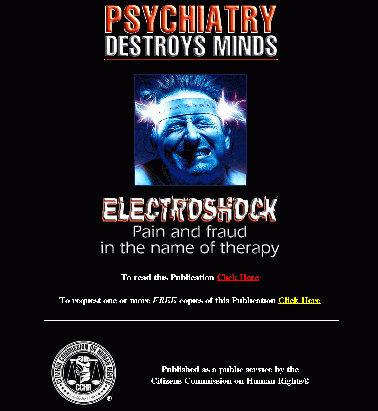 Click to visit CCHR web site
Click to visit CCHR web site With the introduction of past lives, Hubbard switched from a materialist to a dualist conception of mind. In Dianetics, the "I" that looked at mental image pictures was the analyzer. In Scientology the "I" is the thetan, a spirit, that moves from one body to the next, carrying its reactive mind along with it. And in advanced Scientology auditing, subjects are instructed to communicate with their body thetans "telepathically", not verbally.
But Scientology's view of the mind is still the computer metaphor. Mind as "spirit" still operates according to rigid mechanistic laws, but now these laws include the creation and destruction of "mental mass", telepathic communication with other minds, etc.
The notion that thoughts directly affect the physical world is common in magical belief systems. But in positing specific interactions between thetans, mental mass, and nerve channels, Scientology presents a uniquely mechanistic version of dualism.